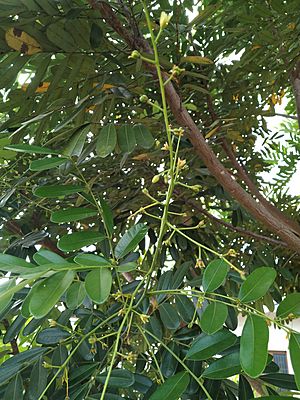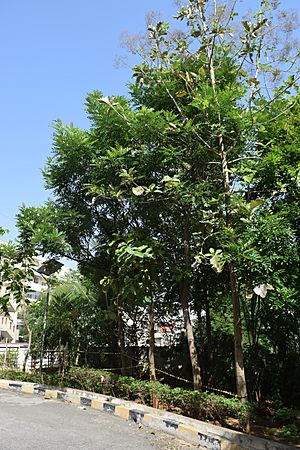Paradise-tree facts for kids
Quick facts for kids Paradise-tree |
|
|---|---|
 |
|
| Conservation status | |
| Scientific classification | |
| Genus: |
Simarouba
|
| Species: |
glauca
|
The Simarouba glauca is a flowering tree. It is also known as Simarouba amara. This tree grows naturally in places like Florida, South America, and the Caribbean. People call it by many names, such as paradise-tree, dysentery-bark, bitterwood, and Lakshmi Taru.
The seeds of this tree can be used to make an edible oil. This means the oil can be eaten. The tree grows best in warm, wet, tropical areas. It needs enough rain and good soil that holds water. It can grow in temperatures from 10 to 40 °C (50 to 104 °F). You can find it from sea level up to 1,000 m (3,300 ft) high. The tree can reach 40 to 50 ft (12 to 15 m) tall. It spreads out about 25 to 30 ft (7.6 to 9.1 m) wide. It has yellow flowers and purple, oval-shaped, fleshy fruits.
Contents
Growing and Reproduction of the Paradise Tree
You can grow the paradise tree in different ways. It can be grown from seeds. You can also use grafting or tissue culture technology. Grafting is when you join parts of two plants so they grow as one. Tissue culture involves growing plants from small pieces of tissue in a lab.
To grow from seeds, people collect the fruits in April or May. This is when the fruits are ripe. Then, they dry the fruits in the sun for about a week. After drying, the skin is removed. The seeds are then planted in plastic bags. This helps them grow into young trees called saplings. When the saplings are 2 to 3 months old, they are ready. They can then be moved to a larger plantation.
Uses of the Simarouba Tree
The wood from the Simarouba tree is strong. It naturally resists insects. Because of this, it is used to make good quality furniture. It is also used for toys and matches. The wood can even be turned into pulp for making paper.
Beyond wood products, the tree has many industrial uses. Its parts can be used to make biofuel. Biofuel is a type of fuel made from plants. It is also used in making soaps, detergents, and lubricants. Lubricants are slippery substances that reduce friction. The tree's extracts are also found in cosmetics and medicines.
Research on Health Claims
Some people claim that parts of the Simarouba tree can help treat certain illnesses. For example, some believe it can help with diarrhea, malaria, fever, or stomach upset. However, there is not enough scientific proof to support these claims.
In India, the tree is known as Lakshmi Taru. Some believe its extracts have strong properties against cancer. But, scientists have not yet done enough research. They need to study how chemicals from Simarouba glauca work in the body. So far, tests have mostly been done in labs, not on living beings. This means we don't know if the same effects would happen in people. Therefore, using Simarouba as a cure for cancer is not proven.
Environmental Benefits of the Simarouba Tree
The Simarouba tree is good for the environment. It grows a strong root system. Its thick, evergreen leaves form a dense canopy. This helps stop soil erosion. Soil erosion is when soil is washed away by wind or water. The tree also helps the tiny living things in the soil. It improves the amount of water in the ground.
This tree uses solar energy all year round. It turns sunlight into energy for growth. It also helps keep the soil surface from getting too hot. This is especially helpful during summer. Planting many of these trees on unused land can help fix that land. It also helps turn carbon dioxide from the air into oxygen. This can help reduce the greenhouse effect and global warming.




